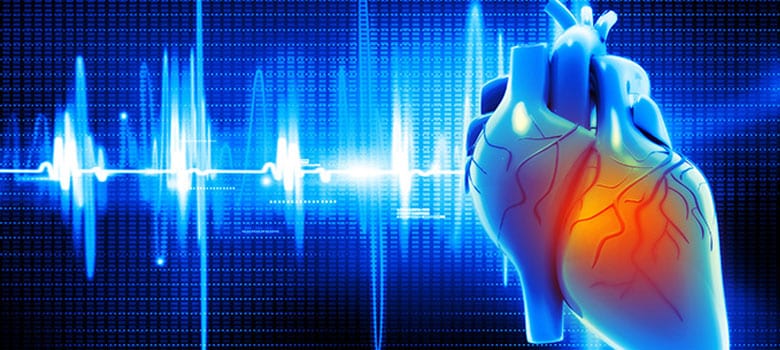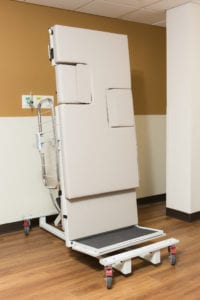

The Hufstetler Heart Center at Colquitt Regional can perform a number of tests to diagnose heart function and detect abnormalities. See below for a full list of services and diagnostics.
Overview
The ankle-brachial index test is a quick, noninvasive way to check for peripheral artery disease (PAD). The disease occurs when narrowed arteries reduce the blood flow to your limbs. PAD can cause leg pain when walking and increases the risk of heart attack and stroke.
The ankle-brachial index test compares the blood pressure measured at your ankle with the blood pressure measured at your arm. A low ankle-brachial index number can indicate narrowing or blockage of the arteries in your legs.
You may have ankle-brachial index testing before and immediately after walking on a treadmill. An exercise ankle-brachial index test can assess the severity of the narrowed arteries during walking.
Why it’s done
The ankle-brachial index test is done to check for PAD — narrowed arteries that reduce blood flow, usually in your legs. Research indicates that PAD affects about 10 percent of people over age 55.
Your doctor might recommend an ankle-brachial index test if you have leg pain while walking or risk factors for PAD, such as:
- History of tobacco use
- Diabetes
- High blood pressure
- High cholesterol
- Restricted blood flow (atherosclerosis) in other parts of your body
Risks
You may feel some discomfort when the blood pressure cuffs inflate on your arm and ankle. But this discomfort is temporary and should stop when the air is released from the cuff.
If you have severe leg pain, your doctor may recommend a different imaging test of the arteries in your legs.
How you prepare
No special preparations are needed for an ankle-brachial index test. The test is painless and similar to getting your blood pressure taken in a routine visit to your doctor. You might want to wear loose, comfortable clothing that allows the technician performing your ankle-brachial index test to easily place a blood pressure cuff on your ankle and upper arm.
During the procedure
Typically, you lie on a table on your back, and a technician measures your blood pressure in both arms and both ankles, using an inflatable cuff and a hand-held ultrasound device that’s pressed on your skin. The device uses sound waves to produce images and allows your pulse to be heard in your ankle arteries after the cuff is deflated.
After the procedure
The ankle-brachial index test should take only a few minutes. You don’t need to follow any special precautions afterward. Your doctor will discuss your test result with you.
Results
Your doctor uses the blood pressure measurements from your arms and ankles to calculate your ankle-brachial index.
Based on the number your doctor calculates, your ankle-brachial index may show you have:
- No blockage (1.0 to 1.4).An ankle-brachial index number in this range suggests that you probably don’t have PAD. But if you have symptoms of PAD, your doctor might perform an exercise ankle-brachial index test.
- Borderline blockage (0.91 to 0.99).An ankle-brachial index number is this range indicates that you have borderline PAD. Your doctor might recommend an exercise ankle-brachial index test.
- PAD (less than 0.90).An ankle-brachial index number in this range is considered abnormal and indicates a diagnosis of PAD. Your doctor may recommend additional testing, such as ultrasound or angiography, to view the arteries in your legs.
If you have severe diabetes or significantly blocked arteries, your doctor may need to read your blood pressure at your big toe (toe-brachial index) to get an accurate test result.
Depending on the severity of your blockage, your doctor may recommend:
- Lifestyle changes
- Medication
- Surgery to treat PAD
Overview
Cardiac catheterization (kath-uh-tur-ih-ZAY-shun) is a procedure used to diagnose and treat certain cardiovascular conditions. During cardiac catheterization, a long thin tube called a catheter is inserted in an artery or vein in your groin or arm and threaded through your blood vessels to your heart.
Using this catheter, doctors can then do diagnostic tests as part of a cardiac catheterization.
Usually, you’ll be awake during cardiac catheterization but be given medications to help you relax. Recovery time for a cardiac catheterization is quick, and there’s a low risk of complications.
Why it’s done
Cardiac catheterization is done to see if you have a heart problem. It can also be done as part of a procedure to correct a known heart problem.
If you’re having cardiac catheterization as a test for heart disease, your doctor can:
- Locate narrowing or blockages in your blood vessels that could cause chest pain (angiogram)
- Measure pressure and oxygen levels in different parts of your heart (hemodynamic assessment)
- Check the pumping function of your heart (right or left ventriculogram)
- Take a sample of tissue from your heart (biopsy)
- Diagnose heart defects present from birth (congenital heart defects)
- Look for problems with your heart valves
Risks
As with most procedures done on your heart and blood vessels, cardiac catheterization has some risks. Major complications are rare, though.
Risks of cardiac catheterization are:
- Bruising
- Bleeding
- Heart attack
- Stroke
- Damage to the artery, heart or the area where the catheter was inserted
- Irregular heart rhythms (arrhythmias)
- Allergic reactions to the dye or medication
- Kidney damage
- Infection
- Blood clots
If you are pregnant or planning to become pregnant, tell your doctor before having the procedure.
How you prepare
Cardiac catheterization is usually performed in the hospital. The test requires some preparations. Before your test:
- Don’t eat or drink anything for at least 6 hours before your test, or as directed by your doctor. Having food or drink in your stomach can increase your risk of complications from sedation. Ask your doctor or nurse if you should take your medications with a small amount of water.
If you have diabetes, ask for instructions about diabetes medications and insulin. You will usually be able to have something to eat and drink soon after your test.
- Your doctor may recommend you stop medications that may thin your blood.
- Take all your medications and supplements with you to the test. It’s best if you take the original bottles so that your doctor will know the exact dose you take.
What you can expect
Before the procedure
You’ll have your blood pressure and pulse checked. You’ll also be asked to use the toilet to empty your bladder.
You’ll need to remove dentures and may need to remove jewelry, especially necklaces that could interfere with pictures of your heart. You’ll wait in a pre-op room until it’s time for your procedure — you can often have someone wait there with you.
During the procedure
Cardiac catheterization is done in a procedure room with special X-ray and imaging machines. Like an operating room, the cardiac catheterization lab is a sterile area.
Cardiac catheterization is usually performed while you’re awake but sedated. However, certain procedures, such as ablation, valve repair or valve replacement, may be performed while you’re under general anesthesia.
An IV line will be inserted in your hand or arm and will be used to give you any additional medications you might need during your procedure. You will also have monitors (electrodes) placed on your chest to check your heartbeat during the test.
Just before the procedure, a nurse or technician may shave the hair from the site where the catheter will be inserted. Before the catheter is inserted in your artery, you’ll be given a shot of an anesthetic to numb the area. You may feel a quick, stinging pain before the numbness sets in.
After you feel numb, the catheter will be inserted. A small cut is made to access an artery. A plastic sheath will be inserted in the cut to allow your doctor to insert the catheter.
What happens next depends on why you’re having a cardiac catheterization. These are some of the common uses for cardiac catheterization:
- Coronary angiogram.If you’re having this test to check for blockages in the arteries leading to your heart, a dye will be injected through the catheter, and X-ray images of your heart arteries will be taken. In a coronary angiogram, the catheter is usually first placed in the artery in your groin or wrist.
- Right heart catheterization.This procedure checks the pressure and blood flow in the right side of your heart. A catheter is inserted in the vein in your neck or groin. The catheter has special sensors in it to measure the pressure and blood flow in your heart.
If you’re awake during the procedure, you may be asked to take deep breaths, hold your breath, cough or place your arms in various positions throughout the procedure. Your table may be tilted at times, but you’ll have a safety strap on to keep you on the table.
Threading the catheter shouldn’t be painful, and you won’t feel it moving through your body. Tell your health care team if you have any discomfort.
After the procedure
You’ll likely spend several hours in a recovery room after the procedure while the anesthesia wears off. The plastic sheath inserted in your groin or arm is usually removed soon after the procedure.
After you leave the recovery room, you’ll go to a regular hospital or outpatient room. After your catheter is removed, the technician or nurse who has removed your sheath will apply pressure to the insertion sites. If the groin is used, you’ll need to lie flat for several hours after the procedure to avoid serious bleeding and to allow the artery to heal.
You’ll be able to eat and drink after the procedure. The length of your stay in the hospital will depend on your condition. You may be able to go home the same day as your catheterization.
Results
If you’re having cardiac catheterization as a test, your doctor should explain the results to you.
If you’ve had a coronary angiogram, your results could mean that you need angioplasty or a stent. If your doctor sees a blockage, you may be transferred for angioplasty with or without a stent placement right away so that you won’t need to have another cardiac catheterization. Your doctor should discuss whether this is a possibility before the procedure begins.
It’s also possible that the test may show you need an open-heart surgery called coronary bypass surgery.
Overview
A heart scan, also known as a coronary calcium scan, is a specialized X-ray test that provides pictures of your heart that can help your doctor detect and measure calcium-containing plaque in the arteries.
Plaque inside the arteries of your heart can grow and restrict blood flow to the muscles of the heart. Measuring calcified plaque with a heart scan may allow your doctor to identify possible coronary artery disease before you have signs and symptoms.
Your doctor will use your test results to determine if you may need medication or lifestyle changes to reduce the risk of heart attack or other heart problems.
Why it’s done
Your doctor may order a heart scan to get a better understanding of your risk of heart disease or if your treatment plan is uncertain.
A heart scan uses a specialized X-ray technology called multi-slice computerized tomography (CT), which creates multiple images of plaque deposits in the blood vessels. The imaging test provides an early look at levels of plaque.
Plaque is made up of fats, cholesterol, calcium and other substances in the blood. It develops gradually over time, long before there are any signs or symptoms of disease. These deposits can restrict the flow of oxygen-rich blood to the muscles of the heart. Plaque also may burst, triggering a blood clot that can cause a heart attack.
When is a heart scan used?
A heart scan may help guide treatment if you have a low to moderate risk of heart disease or if your heart disease risk isn’t clear. Your doctor can tell you if you might benefit from having a heart scan based on your risk factors.
A heart scan also may help motivate people at moderate risk to make important lifestyle changes and follow treatment plans.
When is a heart scan not used?
A heart scan requires exposure to radiation. While the exposure is generally considered safe, the scan isn’t recommended if the risk of radiation exposure outweighs any potential benefit.
According to the American College of Cardiology and the American Heart Association guidelines, a heart scan may not be recommended for the following people:
- Men under age 40 and women under age 50, because it’s unlikely calcium can be detected at younger ages
- People who have a very low risk, because detectable calcium is highly unlikely if you don’t have a family history of heart attacks at an early age
- People with symptoms or a diagnosis of coronary artery disease, because the procedure won’t help doctors better understand the disease progression or risk
- People who already had an abnormal coronary calcium heart scan
Risks
Heart scans use X-ray technology, which require radiation exposure. The amount of exposure is generally considered safe — about the same amount of radiation you’re naturally exposed to in a year.
How you prepare
No prep for the test.
What you can expect
During the procedure
Before the scan begins, the technician attaches sensors, called electrodes, to your chest. These connect to an electrocardiogram (ECG or EKG), which records your heart activity during the exam and coordinates the timing of X-ray pictures between heartbeats, when the heart muscles are relaxed.
During the heart scan, you lie on your back on a movable table, which slides into the tube like CT scanner. Your head is outside the scanner the whole time. The exam room will likely be cool.
You’ll be asked to lie still and hold your breath for a few seconds while the pictures are taken. The technician operates the scanner from a room next door, but can see and talk to you the entire time. The entire procedure should take about 5 to 10 minutes
After the procedure
Usually, no special precautions are needed after having a heart scan. You should be able to drive yourself home and continue your daily activities.
Results
The result of the test is usually given as a number called an Agatston score. The score reflects the total area of calcium deposits and the density of the calcium.
- A score of zero means no calcium is seen in the heart. It suggests a low chance of developing a heart attack in the future.
- When calcium is present, the higher the score, the higher your risk of heart disease.
- A score of 100 to 300 means moderate plaque deposits. It’s associated with a relatively high risk of heart attack or other heart disease over the next three to five years.
- A score greater than 300 is a sign of very high to severe disease and heart attack risk.
You also may receive a percentile score, which indicates your amount of calcium compared to people of the same age and sex.
Discussing results with your doctor
Your doctor will discuss the results of the heart scan with you. Depending on the outcome, one or more of the following strategies may be needed:
- No change to current treatment plan
- Different medication or dose of medication
- Changes to your diet and exercise routine
- New weight-loss goals
- Additional tests
- Follow-up appointments to monitor your health and treatment plan
No appointment or doctor’s order is required to have the cardiac calcium score. To pre-register or for more information, please call 229-890-3500 or send us a message.
Overview
An echocardiogram uses sound waves to produce images of your heart. This common test allows your doctor to see your heart beating and pumping blood. Your doctor can use the images from an echocardiogram to identify heart disease.
Depending on what information your doctor needs, you may have one of several types of echocardiograms. Each type of echocardiogram involves few, if any, risks.
Why it’s done
Your doctor may suggest an echocardiogram to:
- Check for problems with the valves or chambers of your heart
- Check if heart problems are the cause of symptoms such as shortness of breath or chest pain
- The type of echocardiogram you have depends on the information your doctor needs.
Transthoracic echocardiogram
In this standard type of echocardiogram:
- A technician (sonographer) spreads gel on a device (transducer).
- The sonographer presses the transducer firmly against your skin, aiming an ultrasound beam through your chest to your heart.
- The transducer records the sound wave echoes from your heart.
- A computer converts the echoes into moving images on a monitor.
If your lungs or ribs block the view, you may need a small amount of an enhancing agent injected through an intravenous (IV) line. The enhancing agent, which is generally safe and well tolerated, will make your heart’s structures show up more clearly on a monitor.
Transesophageal echocardiogram
If your doctor wants more-detailed images or it’s difficult to get a clear picture of your heart with a standard echocardiogram, your doctor may recommend a transesophageal echocardiogram.
In this procedure:
- You will be given medications to help you relax.
- A flexible tube containing a transducer is guided down your throat and into the tube connecting your mouth to your stomach (esophagus).
- The transducer records the sound wave echoes from your heart.
- A computer converts the echoes into detailed moving images of your heart, which your doctor can view on a monitor.
Doppler echocardiogram
Sound waves change pitch when they bounce off blood cells moving through your heart and blood vessels. These changes (Doppler signals) can help your doctor measure the speed and direction of the blood flow in your heart.
Doppler techniques are generally used in transthoracic and transesophageal echocardiograms. Doppler techniques can also be used to check blood flow problems and blood pressure in the arteries of your heart — which traditional ultrasound might not detect.
The blood flow shown on the monitor is colorized to help your doctor pinpoint any problems.
Stress echocardiogram
Some heart problems — particularly those involving the arteries that supply blood to your heart muscle (coronary arteries) — occur only during physical activity. Your doctor might recommend a stress echocardiogram to check for coronary artery problems. However, an echocardiogram can’t provide information about any blockages in the heart’s arteries.
In a stress echocardiogram:
- Ultrasound images of your heart are taken before and during the stress test as you pedal on the stationary bike that is attached to the bottom of the bed.
- If you’re unable to exercise, you may get an injection of a medication to make your heart pump as hard as if you were exercising.
Risks
No risks are involved in a standard transthoracic echocardiogram. You may feel some discomfort from the transducer being held very firmly against your chest. The firmness is necessary to produce the best images of your heart.
If you have a transesophageal echocardiogram, your throat may be sore for a few hours afterward. Rarely, the tube may scrape the inside of your throat. Your oxygen level will be monitored during the exam to check for any breathing problems caused by sedation medication.
During a stress echocardiogram, exercise or medication — not the echocardiogram itself — may temporarily cause an irregular heartbeat. Serious complications, such as a heart attack, are rare.
How you prepare
Food and medications
No special preparations are necessary for a standard transthoracic echocardiogram. You can eat, drink and take medications as you normally would.
If you’re having a transesophageal echocardiogram, your doctor will ask you not to eat for several hours beforehand.
Other precautions
If you’re having a transesophageal echocardiogram, you won’t be able to drive afterward because of the medication you’ll likely receive. Be sure to arrange for a ride home.
What you can expect
During the procedure
An echocardiogram can be done in the doctor’s office or a hospital.
For a standard transthoracic echocardiogram:
- You’ll undress from the waist up and lie on an examination table or bed.
- The technician will attach sticky patches (electrodes) to your body to help detect and conduct your heart’s electrical currents.
- The technician will also apply a gel to the transducer that improves the conduction of sound waves.
- The technician will move the transducer back and forth over your chest to record images of sound-wave echoes from your heart. You may hear a pulsing “whoosh,” which is the ultrasound recording the blood flowing through your heart.
- You may be asked to breathe in a certain way or to roll onto your left side.
If you have a transesophageal echocardiogram:
- Your throat will be numbed with a spray or gel
- You’ll be given a sedative to help you relax
- The tube containing the transducer will be guided down your throat and into your esophagus, and positioned to obtain images of your heart
Most echocardiograms take less than an hour. If you have a transesophageal echocardiogram, you may be watched for a few hours at the doctor’s office or hospital after the test.
After the procedure
Most people can resume their normal daily activities after an echocardiogram.
If your echocardiogram is normal, no further testing may be needed. If the results are concerning, you may be referred to a doctor trained in heart conditions (cardiologist) for more tests.
Results
Information from the echocardiogram may show:
- Changes in your heart size.Weakened or damaged heart valves, high blood pressure or other diseases can cause the chambers of your heart to enlarge or the walls of your heart to be abnormally thickened.
- Pumping strength.The measurements obtained from an echocardiogram include the percentage of blood that’s pumped out of a filled ventricle with each heartbeat (ejection fraction) and the volume of blood pumped by the heart in one minute (cardiac output). A heart that isn’t pumping enough blood to meet your body’s needs can lead to symptoms of heart failure.
- Damage to the heart muscle.An echocardiogram helps your doctor determine whether all parts of the heart wall are contributing normally to your heart’s pumping activity. Areas of heart wall that move weakly may have been damaged during a heart attack, or be receiving too little oxygen.
- Valve problems.An echocardiogram can help your doctor determine if your heart valves open wide enough for adequate blood flow or close fully to prevent blood leakage.
- Heart defects.An echocardiogram can show problems with the heart chambers, abnormal connections between the heart and major blood vessels, and complex heart defects that are present at birth.
An implantable loop recorder is a type of heart-monitoring device that records your heart rhythm continuously for up to three years. It records the electrical signals of your heart and allows remote monitoring by way of a small device inserted just beneath the skin of the chest.
Why it’s done
An implantable loop recorder can help answer questions about your heart that other heart-monitoring devices don’t provide. It allows for long-term heart rhythm monitoring. It can capture information that a standard electrocardiogram (ECG or EKG) or Holter monitor misses because some heart rhythm abnormalities occur infrequently.
For example, if you have a standard ECG to help figure out why you’re having fainting spells, it will only record any related heart rhythm abnormalities during the few minutes of the monitoring period — usually about five minutes. Because an implantable loop recorder monitors your heart signals for a much longer time, it’s more likely to capture what your heart is doing during your next fainting spell. This information may help your doctor make a definite diagnosis and develop a treatment plan.
Implantable loop recorders are one of the newer heart-monitoring devices. Researchers have evaluated their safety and benefit over the last 10 years. A study of 579 people with fainting spells showed that implantable loop recorders had a higher rate of diagnosis of heart rhythm problems than did other monitoring devices.
Researchers also examined the value of implantable loop recorders in people who had a stroke. Long-term heart monitoring uncovered heart rhythm problems that caused the stroke better than 24-hour monitoring did. Doctors used these results to guide treatment with blood-thinning drugs (anti-coagulation therapy) to prevent another stroke.
What you can expect
You will need to undergo a minor surgical procedure to place the implantable loop recorder. Risks of the procedure include infection or a reaction to the device that causes redness at the incision site.
Before the procedure
You don’t need to do anything special to prepare for this procedure.
During the procedure
The procedure to insert the heart monitor is usually done in a doctor’s office, with a local anesthetic. Your doctor makes a tiny incision, inserts the device, which is smaller than a key or a thumb drive, and closes the incision. The device stays in place for up to three years.
After the procedure
The procedure to insert an implantable loop recorder has some risk because it involves minor surgery. Your care team will advise you to watch your incision for signs of infection and, perhaps, to limit activities until the wound heals.
The device records the electrical impulses of your heart and transmits them automatically to your doctor by way of the internet and wireless technology. All you need to do is keep the transmission monitor your doctor gives you beside your bed. Transmissions occur while you’re asleep. You can also activate the data transmission process yourself. In addition, your doctor may ask you to keep a diary of your symptoms.
Your doctor will interpret the results of your test and call you if he or she has any concerns. You’ll likely need to see your doctor once or twice a year for routine checkups while the device is in place.
An implantable loop recorder is invisible and doesn’t interfere with your daily activities. It has no patches or wires, and you don’t have to worry about getting the device wet while bathing or swimming. These devices are supposed to be safe for use during a medical imaging procedure called magnetic resonance imaging (MRI), but let your doctor know about your implant before you schedule such a test.
It’s also possible an implantable loop recorder might set off metal detectors, for example, at an airport. Your doctor can provide you with a device identification card to carry with you for such situations.
Overview
A nuclear stress test uses radioactive dye and an imaging machine to create pictures showing the blood flow to your heart. The test measures blood flow while you are at rest and are exerting yourself, showing areas with poor blood flow or damage in your heart.
The test usually involves injecting radioactive dye, then taking two sets of images of your heart — one while you’re at rest and another after stress.
A nuclear stress test is one of several types of stress tests that may be performed alone or in combination. Compared with an exercise stress test, a nuclear stress test can help better determine your risk of a heart attack or other cardiac event if your doctor knows or suspects that you have coronary artery disease.
Why it’s done
You may need a nuclear stress test if a routine stress test didn’t pinpoint the cause of symptoms such as chest pain or shortness of breath. A nuclear stress test may also be used to guide your treatment if you’ve been diagnosed with a heart condition. Your doctor may recommend a nuclear stress test to:
- Diagnose coronary artery disease.Your coronary arteries are the major blood vessels that supply your heart with blood, oxygen and nutrients. Coronary artery disease develops when these arteries become damaged or diseased — usually due to a buildup of deposits containing cholesterol and other substances (plaques).
If you have symptoms such as chest pain or shortness of breath, a nuclear stress test can help determine if you have coronary artery disease and how severe the condition is.
- Guide treatment of heart disorders.If you’ve been diagnosed with coronary artery disease, a nuclear stress test can help your doctor find out how well treatment is working. It may also be used to help establish the right treatment plan for you by determining how much exercise your heart can handle.
Risks
A nuclear stress test is generally safe, and complications are rare. As with any medical procedure, there is a risk of complications, including:
- Abnormal heart rhythms (arrhythmias).Arrhythmias brought on during a stress test usually go away shortly after you stop exercising or the medication wears off. Life-threatening arrhythmias are rare.
- Heart attack (myocardial infarction).Although extremely rare, it’s possible that a nuclear stress test could cause a heart attack.
- Dizziness or chest pain.These symptoms can occur during a stress test. Other possible signs and symptoms include nausea, shakiness, headache, flushing, shortness of breath and anxiety. These signs and symptoms are usually mild and brief, but tell your doctor if they occur.
- Low blood pressure.Blood pressure may drop during or immediately after exercise, possibly causing you to feel dizzy or faint. The problem should go away after you stop exercising.
How you prepare
Your doctor will give you specific instructions on how to prepare for your nuclear stress test.
Food and medications
You may be asked not to eat, drink or smoke for a period of time before a nuclear stress test. You may need to avoid caffeine the day before and the day of the test.
Ask your doctor if it’s safe for you to continue taking all of your prescription and over-the-counter medications before the test, because they might interfere with certain stress tests.
If you use an inhaler for asthma or other breathing problems, bring it to the test. Make sure your doctor and the health care team member monitoring your stress test know that you use an inhaler.
Clothing and personal items
Wear or bring comfortable clothes and walking shoes. Don’t apply oil, lotion or cream to your skin on the day of your nuclear stress test.
What you can expect
A nuclear stress test may be performed in combination with an exercise stress test, in which you walk on a treadmill. If you aren’t able to exercise, you’ll receive a drug through an IV that mimics exercise by increasing blood flow to your heart. A nuclear stress test can take two or more hours, depending on the radioactive material and imaging tests used.
During a nuclear stress test
Before you start the test, a technician inserts an intravenous (IV) line into your arm and injects a radioactive dye (radiopharmaceutical or radiotracer).
The radiotracer may feel cold when it’s first injected into your arm. It takes about 20 to 40 minutes for your heart cells to absorb the radiotracer. Then, you’ll lie still on a table and have your first set of images taken while your heart is at rest.
A nurse or technician will place sticky patches (electrodes) on your chest, legs and arms. Some areas may need to be shaved to help them stick. The electrodes have wires connected to an electrocardiogram machine, which records the electrical signals that trigger your heartbeats. A cuff on your arm checks your blood pressure during the test. You may be asked to breathe into a tube during the test to show how well you’re able to breathe during exercise.
If you can’t exercise, your doctor will inject the drug into your IV line that mimics exercise by increasing blood flow to your heart. Possible side effects may be similar to those caused by exercise, such as flushing or shortness of breath. You might get a headache.
For an exercise stress test, you’ll walk on a treadmill. You’ll start slowly, and the exercise gets more difficult as the test progresses. You can use the railing on the treadmill for balance. Don’t hang on tightly, as this may skew the results.
You’ll continue exercising until either your heart rate has reached a set target, you develop symptoms that don’t allow you to continue or you develop:
- Moderate to severe chest pain
- Severe shortness of breath
- Abnormally high or low blood pressure
- An abnormal heart rhythm
- Dizziness
- Certain changes in your electrocardiogram
You and your doctor will discuss your safe limits for exercise. You can stop the test anytime you’re too uncomfortable to continue.
You’ll have another injection of radiotracer when your heart rate peaks. About 20 to 40 minutes later, you’ll lie still on a table and have a second set of images made of your heart muscle. The dye shows any areas of your heart receiving inadequate blood flow.
Your doctor will use the two sets of images to compare the blood flow through your heart while you’re at rest and under stress.
After a nuclear stress test
After you stop exercising, you might be asked to stand still for several seconds and then sit down for a period of time with the monitors in place. Your doctor can watch for any abnormalities as your heart rate and breathing return to normal.
When the test is complete, you may return to normal activities unless your doctor tells you otherwise. The radioactive material will naturally leave your body in your urine or stool. Drink plenty of water to help flush the dye out of your system.
Results
Your doctor will discuss your nuclear stress test results with you. Your results could show:
- Normal blood flow during exercise and rest.You may not need further tests.
- Normal blood flow during rest, but not during exercise.Part of your heart isn’t receiving enough blood when you’re exerting yourself. This might mean that you have one or more blocked arteries (coronary artery disease).
- Low blood flow during rest and exercise.Part of your heart isn’t getting enough blood at all times, which could be due to severe coronary artery disease or a previous heart attack.
- Lack of radioactive dye in parts of your heart.Areas of your heart that don’t show the radioactive dye have tissue damage from a heart attack.
If you don’t have enough blood flow through your heart, you may need to undergo coronary angiography. This test looks directly at the blood vessels supplying your heart. If you have severe blockages, you may need a coronary intervention (angioplasty and stent placement) or open-heart surgery (coronary artery bypass).
Overview
A tilt table test is used to evaluate the cause of unexplained fainting.

Your doctor might recommend a tilt table test if you have repeated, unexplained episodes of lightheadedness, dizziness or fainting. The test can help determine if the cause is related to your heart rate or blood pressure.
Why it’s done
Your doctor might recommend a tilt table test to try to trigger your signs and symptoms — lightheadedness, dizziness or fainting — while your heart rate and blood pressure are being monitored.
Your nervous system controls your heart rate and blood pressure. It may suddenly lower your heart rate and blood pressure for a short time when you’re moved to an upright position during the tilt table test. As a result, less blood flows to your brain, possibly causing you to faint.
Risks
A tilt table test is generally safe, and complications are rare. But, as with any medical procedure, it does carry some risk.
Potential complications include:
- Nausea and vomiting after fainting
- Weakness that can last several hours
- Prolonged low blood pressure after the test
These complications usually go away when the table is returned to a horizontal position.
How you prepare
You might be asked not to eat or drink for two hours or more before a tilt table test. You can take your medications as usual, unless your doctor tells you otherwise.
What you can expect
To prepare you for the test, a member of your health care team will:
- Have you lie flat on a tablethat has a footboard and place straps around you to hold you in place.
- Place sticky patches (electrodes) on your chest, legs and arms.Wires connect the electrodes to an electrocardiogram machine that monitors your heart rate.
- Place a blood pressure monitor or cuff on your finger, on your arm or on bothto check your blood pressure during the test.
- Place an IV line into a vein in your armfor delivering medication, if needed.
During a tilt table test
- You’ll start by lying flat on your back on the motorized table for about five minutes.
- You’ll be moved to a nearly vertical position, where you’ll remain from five to 45 minutes, depending on the reason for the test. While vertical, you’ll be asked to remain as still as possible but to report signs and symptoms such as nausea, sweating, lightheadedness or irregular heartbeats.
- If you don’t faint or have other symptoms after 45 minutes, you might receive the medication isoproterenol (Isuprel) by the nurse. The medication might prompt the abnormal nervous system reflex that causes you to faint.
- You then remain in the upright position for another 15 to 20 minutes.
Your heart rate and blood pressure will be monitored in each position to evaluate your body’s cardiovascular response to the change in position.
After a tilt table test
If you faint while vertical, the table will be returned to a horizontal position immediately and you’ll be monitored. Most people regain consciousness almost immediately.
In some cases, if blood pressure and heart rate changes indicate you are about to faint, the table is returned to a horizontal position so that you don’t lose consciousness.
When the test is complete, you can return to your normal activities.
Results
The results of a tilt table test are based on whether you faint during the test and what happens to your blood pressure and heart rate.
The result is positive if your blood pressure decreases and you feel dizziness or faint during the test.
The result is negative if your heart rate increases only slightly, your blood pressure doesn’t drop significantly, and you don’t have signs or symptoms of fainting.
Depending on the results, your doctor might recommend additional tests to exclude other causes of fainting.
Overview
A stress test, also called an exercise stress test, shows how your heart works during physical activity. Because exercise makes your heart pump harder and faster, an exercise stress test can reveal problems with blood flow within your heart.
A stress test usually involves walking on a treadmill or riding a stationary bike while your heart rhythm, blood pressure and breathing are monitored. Or you’ll receive a drug that mimics the effects of exercise.
Your doctor may recommend a stress test if you have signs or symptoms of coronary artery disease or an abnormal heart rhythm (arrhythmia).
A stress test can help:
- Guide treatment decisions
- Determine how well heart treatment is working
- Diagnose the severity of an existing heart condition
Why it’s done
Your doctor may recommend a stress test to:
- Diagnose coronary artery disease. Your coronary arteries are the major blood vessels that supply your heart with blood, oxygen and nutrients. Coronary artery disease develops when these arteries become damaged or diseased — usually due to a buildup of deposits containing cholesterol and other substances (plaques).
- Diagnose heart rhythm problems (arrhythmias). Heart arrhythmias occur when the electrical signals that coordinate your heartbeat don’t work properly. An arrhythmia can cause your heart to beat too fast, too slowly or irregularly.
- Guide treatment of heart disorders. If you’ve already been diagnosed with a heart condition, an exercise stress test can help your doctor determine if your current treatment is working. The test results also help your doctor decide on the best treatment for you.
- Check your heart before surgery. Your doctor may use a stress test to determine when you can safely have surgery, such as valve replacement or a heart transplant.
If an exercise stress test doesn’t pinpoint the cause of your signs and symptoms, your doctor may recommend a stress test with imaging, such as a nuclear stress test or stress test with an echocardiogram.
A peripheral angiogram is a test that uses X-rays and dye to help your doctor find narrowed or blocked areas in one or more of the arteries that supply blood to your legs. The test is also called a peripheral arteriogram. Doctors use a peripheral angiogram if they think blood is not flowing well in the arteries leading to your legs or, in rare cases, to your arms. The angiogram helps you and your doctor decide if a surgical procedure is needed to open the blocked arteries. Peripheral angioplasty is one such procedure. It uses a balloon catheter to open the blocked artery from the inside.
Interventional radiology (IR) is a medical specialty that uses image-guided procedures to diagnose and treat diseases in nearly every organ system. IR procedures are minimally invasive, using techniques such as X-rays, ultrasound, CT scans, and MRI to guide tiny instruments through blood vessels or other pathways to treat conditions without the need for traditional surgery.

















